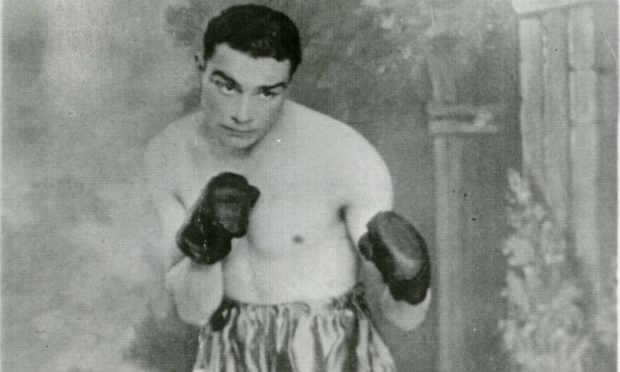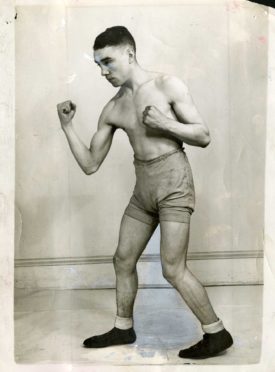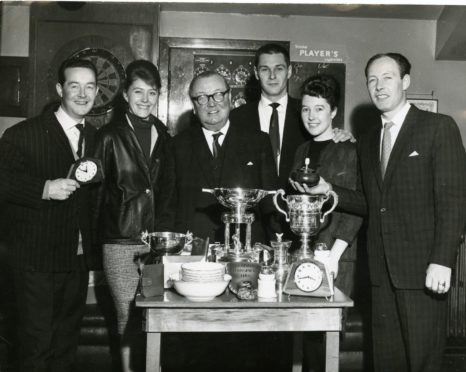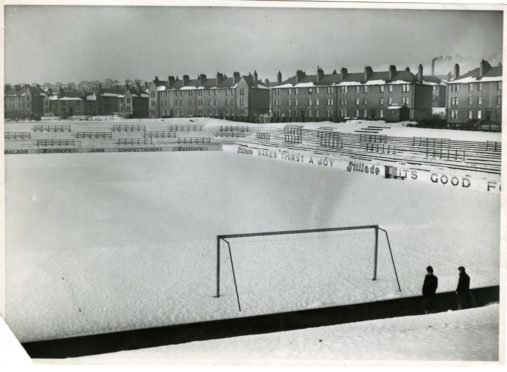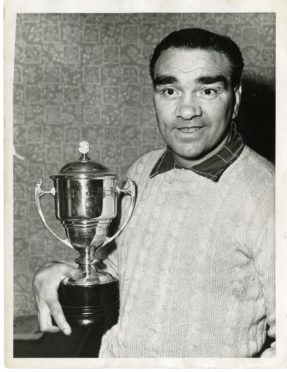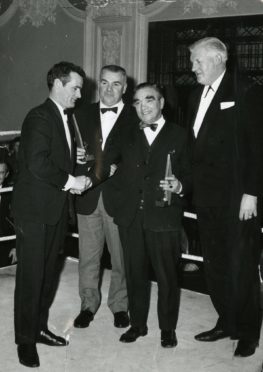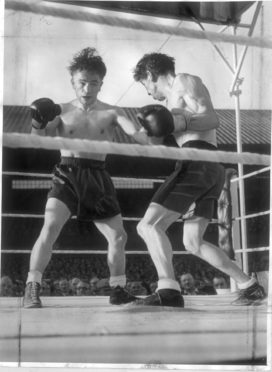Fight fans dived for shelter to the sounds of air-raid sirens during an open-air title bout in Dundee which took place in a blizzard 80 years ago.
The British Empire bantamweight title fight between local boxer Jim Brady and Richie ‘Kid’ Tanner of British Guiana must rank as one of the strangest of all time.
A German invasion was thought to be imminent and the outbreak of World War Two had already put the brakes on many sporting events including the football season.
Promoter George ‘Lucky’ Grant thought the war-weary city would benefit from a boost and pitted Brady against Tanner for the vacant title at Dundee United’s Tannadice Park.
But instead of organising the bout for a summer afternoon or evening, George sensed that a public holiday in winter might bring out the Dundee public.
So he picked New Year’s Day.
Judging public mood
He explained later: “My reasoning was sound enough, even if it didn’t work out right.
“Usually there was a big football match on at Tannadice, which was always well attended.
“This time – it was 1940-41 – there was no match, and I stepped in and booked the park on the basis that there would be plenty people on holiday and free to watch local boy Brady in a title fight.”
At first it seemed as if George’s uncanny antenna for judging public mood – and the elements – was switched on and working perfectly.
Tickets began selling at the rate of his best indoor shows and the demand kept his staff busy into Hogmanay.
He recalled, “In fact, I was still selling tickets right up to ten minutes to midnight on New Year’s Eve – and when I left my office to go home and bring in the New Year, I thought I was certain to start that year with a good piece of business.”
Affectionately known as Dundee’s ‘Mr Boxing’, George was born in Princes Street in 1905.
He got a job with DC Thomson as a newspaper boy aged just five, selling copies of the Evening Telegraph and later The Courier.
Humble beginnings
From these humble beginnings, he left school at 14, working as a bookmaker’s assistant.
By the 1930s George had entered the world of boxing promotion, organising Wednesday evening fights at Premierland stadium which was in William Lane.
He started to organise bigger contests and by 1936 was selling 2,000-plus seats for fights in the Caird Hall.
Crowds also flocked to see outdoor shows put on by George at venues such as Dens Park, Dundee Ice Rink and Station Park in Forfar.
At around this time he began to become known as ‘Lucky’ Grant because every time he organised an open-air show, he took a risk, and the sun seemed to shine.
This time it was not to be.
Biographer Dr Norman Watson said: “George’s optimism evaporated when he woke up next morning to find the streets covered ankle deep in snow.
“As he walked up Tannadice Street to the stadium, and people kept wishing him a Happy New Year, he recalled never feeling in a less festive mood in his life.
“As luck would have it, the snow stopped and an army of volunteers cleared the spectator areas in the stadium.
“In those days, Tannadice was not the enclosed stadium it is now.
“It had one grandstand and open terraces on three sides – and it took a great effort to ready it for the promotion.
“But just as ‘Lucky’ Grant thought he had worked his way out of trouble once again, the air raid sirens went and what spectators had turned up waiting for the gates to open immediately dived for shelter.
“And to compound his misery, another blizzard swept over the stadium as the boxing finally got under way!
“The promotion was as dead as a dodo, of course.
“The Evening Telegraph reported that the crowd was slow in turning up and that ‘only 1,500’ had watched the first boxers step into the ring.
“And even when the afternoon’s main attraction drew a fanfare from the Dundee Military Band, the paper commented mournfully that the crowd had only increased to a miserly 2,000.”
BBC broadcast
To make matters worse, George had agreed that the BBC would broadcast the Brady-Tanner fight on the Programmes For The Forces wavelength, which could be heard across Britain.
This also hit the attendance on such a cold day – even among those who had bought tickets in advance.
Dr Watson said: “George later put the attendance at 3,000, some 9,000 short of the 12,000 he had catered for – and he admitted losing hundreds of pounds on the venture.
“That was not the end of his misfortune.
“To add insult to injury, George was made aware that the BBC had cut the last two rounds of the title fight to put on the next scheduled programme – a concert by the Charles Ernesco Quintet.”
Brady previously toppled Londoner Pat Palmer to win the British Southern Area bantamweight title at Dens Park in 1938 which was his first championship victory.
History repeated itself from that night in ’38 and the battling Brady claimed the Commonwealth bantamweight title after a points victory.
When a few Dundee punters had the hard neck to complain that they had missed the fight’s ending, George justifiably blew his top.
“You can imagine my feelings when they asked me if I intended to protest to the BBC about them terminating the broadcast at the fourteenth round, the best part of the show,” said George.
“To my knowledge, these gentlemen lived within a few minutes’ walk from Tannadice Park, but hadn’t bothered getting tickets for the contest.
“So I told them in no uncertain manner just what I thought about their complaint!”
World title fight
George eventually took it on the chin and saw the funny side of it all.
Dr Watson said the otherwise dreary show had, nonetheless, put the city on the international fight map.
In fact, Brady’s points win over Tanner put him in line for a tilt at the world title held by the American Lou Salic.
George immediately cabled Salic with an offer to stage the head-to-head in Scotland.
Alas, it never happened but George did go on to became the only Dundonian to have promoted a world-title fight.
Mr Grant paid the modern-day equivalent of £150,000 to secure the bout between Scot Jackie Paterson and Liverpudlian Joe Curran at Hampden Park in July 1946.
The contest was watched by more than 45,000 people and Paterson won on points.
Dundee was a hotbed of boxing
A working class city with a love of boxing, Dundee was a hotbed of fighting for decades.
Although the city’s history with the professional game stretches back to 1891, the first outdoor boxing show took place in Dundee on August 4 1920.
Fervent fight fans flocked to Tannadice to see Jim Mack and Jim Crawford slug it out in the squared circle.
Boxing took centre stage at Tannadice again in September 1920.
Caird Hall
A winless Hop Lawson picked up his first victory against veteran Frank Johnson.
Contests dwindled until 1923 when the newly constructed Caird Hall kicked off its pugilistic legacy.
The Scottish heavyweight title was contested between Alex Bell and Bob Scally at Dens Park in 1939.
One of Scotland’s greatest ever boxers, Jackie Paterson, also fought on the bill.
Dens hosted the city’s last two stadium events, the penultimate in August 1942 which saw Freddie Tennant take on Johnny Kelly before Terry Allen boxed Freddie’s brother Norman Tennant in June 1949.
